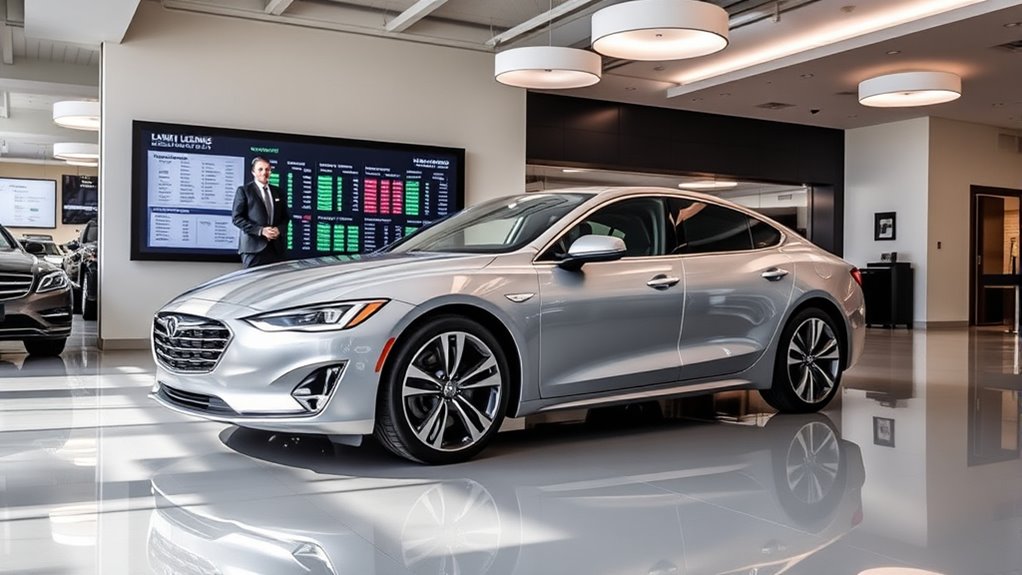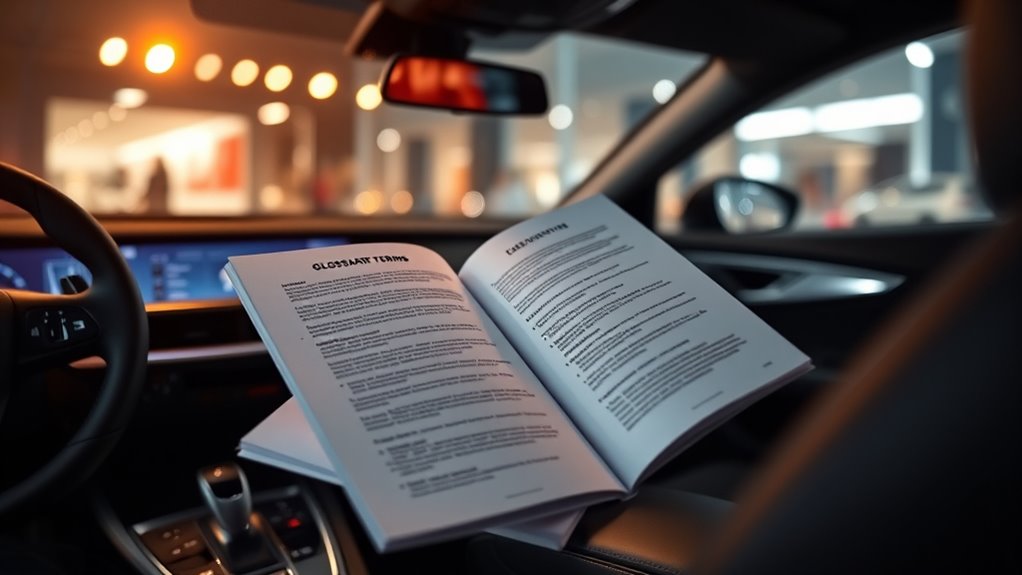When you lease a car, understanding key terms like residual value—the car’s estimated worth at lease end—is essential. The lease period is the contract duration that influences payments and timing for decisions, such as returning, buying outright, or extending the lease. A higher residual value usually means lower monthly costs, but your choice depends on market value and personal needs. Keep exploring these terms to make smarter leasing decisions and optimize your experience beyond the basics.
Key Takeaways
- Residual value is the estimated worth of the car at lease end, affecting payments and buying options.
- Lease end options include returning the car, buying it outright, or extending the lease.
- The lease period is the duration of the contract, influencing residual value and decision timing.
- Higher residual value typically results in lower monthly payments and impacts whether to buy or return.
- Understanding leasing terms helps beginners make informed decisions and optimize their leasing experience.

Are you familiar with the key terms involved in car leasing? Understanding these terms can make the process much less overwhelming and help you make better decisions. One important concept to grasp is what happens at the end of your lease, known as lease end options. When your leasing period concludes, you typically have several choices. You might decide to return the car and walk away, buy it outright if your lease allows, or sometimes extend the lease for a short period. Knowing your lease end options in advance can save you time and money, and it helps you prepare financially for what’s next. Additionally, understanding the role of cookie usage in online car leasing services can provide insights into how digital platforms tailor information to your preferences. Another vital term is residual value. This is the estimated worth of the car at the end of your lease term. Think of residual value as the projected future value of the vehicle, which is set at the beginning of your lease. It plays a significant role in determining your monthly payments. If the residual value is high, your monthly payments tend to be lower because the car is expected to retain more of its value. Conversely, a lower residual value might mean higher monthly payments, as the leasing company anticipates the vehicle will depreciate more. Residual value is calculated based on factors like the car’s make, model, expected mileage, and overall condition.
Understanding residual value is also key if you’re considering buying the car at lease end. If the residual value is lower than the actual market value at that time, you might have the opportunity to purchase the vehicle for less than its worth. Conversely, if the residual value is high, buying the car might not be as financially advantageous compared to simply returning it. When it comes to lease end options, your choice often depends on your vehicle’s residual value and your personal needs. If the residual value aligns well with market conditions, returning the car might be the simplest route. But if you’ve grown attached to the vehicle, and the residual value is favorable, buying it could be a smart move.
Frequently Asked Questions
How Does Early Termination Affect My Lease Agreement?
When you terminate your lease early, you’ll likely face lease penalties and fees for contract cancellation. These costs compensate for the remaining lease payments and potential depreciation. Early termination can also impact your credit score and future leasing options. Before proceeding, review your lease agreement to understand specific penalties and procedures. Planning ahead or negotiating with your leasing company might help minimize costs associated with ending your lease early.
What Is the Difference Between Closed-End and Open-End Leases?
A closed-end lease lets you return the car at the end, with your liability limited to mileage limits and potential wear and tear. You don’t worry about lease residuals beyond the agreed amount. In contrast, an open-end lease makes you responsible for the vehicle’s actual residual value, which can be affected by mileage limits and condition. Choose based on your driving habits and how much control you want over the residuals.
Are There Any Hidden Fees in Car Leasing Contracts?
You might think leasing is straightforward, but hidden fees can surprise you. While lease fees are usually clear, watch out for extra charges like a security deposit or end-of-lease wear and tear fees that aren’t always upfront. Always read your contract carefully to spot these potential costs. Being aware helps you avoid unexpected expenses, so you can enjoy your lease without surprises.
Can I Customize or Modify a Leased Vehicle?
You generally can’t freely customize or modify a leased vehicle, as lease agreements typically prohibit vehicle customization. If you’re interested in lease modifications, you should check with your leasing company first, since some may allow limited changes or offer options for customization. Keep in mind that any unauthorized vehicle customization could lead to additional charges or penalties when returning the vehicle, so always clarify what’s permitted before making modifications.
What Happens at the End of the Lease Term?
Oh, so you thought you’d keep that shiny lease forever? At the end, you return the car, possibly negotiating a lease extension if you’re still smitten. The residual value guides whether you buy or lease again, based on the car’s worth. If you’ve kept it in good shape, you might even negotiate a better deal. Otherwise, you simply hand it back and start anew, hopefully wiser.
Conclusion
Now that you know these car leasing terms, you’re practically a car leasing wizard! No more confusion or hidden surprises—you’re armed and ready to conquer any lease deal out there. Imagine negotiating like a pro, saving thousands, and driving off in that dream car without breaking a sweat. So go ahead, take charge of your leasing journey, and turn those confusing terms into your secret weapon. The road to smart leasing starts with you—so hit the gas and own it!










